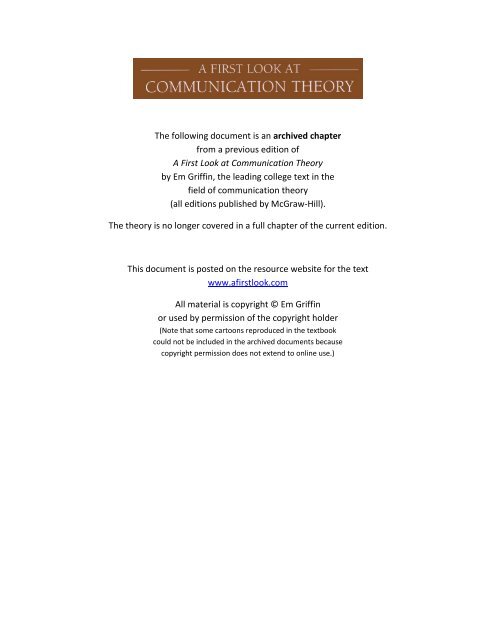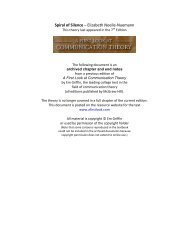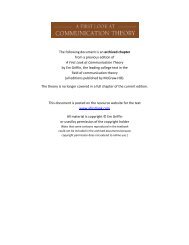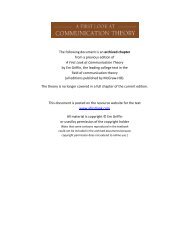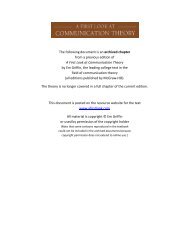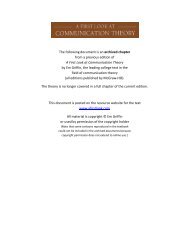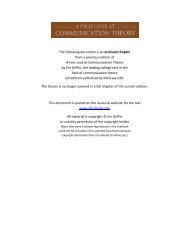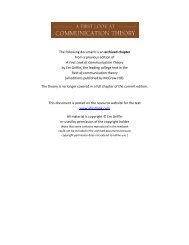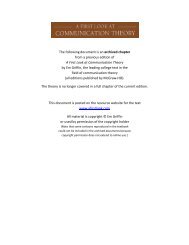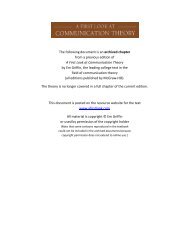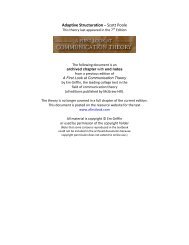Attribution Theory of Fritz Heider - A First Look at Communication ...
Attribution Theory of Fritz Heider - A First Look at Communication ...
Attribution Theory of Fritz Heider - A First Look at Communication ...
Create successful ePaper yourself
Turn your PDF publications into a flip-book with our unique Google optimized e-Paper software.
The following document is an archived chapter<br />
from a previous edition <strong>of</strong><br />
A <strong>First</strong> <strong>Look</strong> <strong>at</strong> Communic<strong>at</strong>ion <strong>Theory</strong><br />
by Em Griffin, the leading college text in the<br />
field <strong>of</strong> communic<strong>at</strong>ion theory<br />
(all editions published by McGraw-Hill).<br />
The theory is no longer covered in a full chapter <strong>of</strong> the current edition.<br />
This document is posted on the resource website for the text<br />
www.afirstlook.com<br />
All m<strong>at</strong>erial is copyright © Em Griffin<br />
or used by permission <strong>of</strong> the copyright holder<br />
(Note th<strong>at</strong> some cartoons reproduced in the textbook<br />
could not be included in the archived documents because<br />
copyright permission does not extend to online use.)
CHAPTER II<br />
<strong>Attribution</strong> <strong>Theory</strong><br />
<strong>of</strong> <strong>Fritz</strong> <strong>Heider</strong><br />
My wife, Jean, served on a jury in a federal case involving conspiracy,<br />
racketeering, drug dealing, armed robbery, and extortion. The seven defen-<br />
dants were accused <strong>of</strong> being the lieutenants in the “Little Mafia” gang which<br />
terrorized a Chicago neighborhood. The gang leader had escaped from police<br />
custody and was on the FBI’s most-wanted list.<br />
The key government witness was an ex-gang member named Larry. Larry<br />
was called “the Canary” by the defendants because he turned informer. For<br />
two months Jean listened to the testimony and tried to figure out whether<br />
Larry’s story was credible. Was his behavior on the witness stand th<strong>at</strong> <strong>of</strong> a<br />
p<strong>at</strong>hological liar, a rejected pal seeking revenge, a petty crook who would say<br />
anything to save his own skin, or an honest witness dedic<strong>at</strong>ed to the truth?<br />
<strong>Fritz</strong> <strong>Heider</strong>, the Austrian-born f<strong>at</strong>her <strong>of</strong> <strong>at</strong>tribution theory, said th<strong>at</strong> we all<br />
face the same task Jean confronted-trying to figure out personality from<br />
behavior.<br />
<strong>Heider</strong>, who became a psychologist and taught <strong>at</strong> the University <strong>of</strong><br />
Kansas, said th<strong>at</strong> <strong>at</strong>tribution is the process <strong>of</strong> drawing inferences. We see a<br />
person act and immedi<strong>at</strong>ely reach conclusions th<strong>at</strong> go beyond mere sensory<br />
inform<strong>at</strong>ion. Suppose Larry yawns while on the stand. Is he bored, afraid,<br />
tired, or indifferent? Jean will search for an explan<strong>at</strong>ion th<strong>at</strong> makes sense to<br />
her. <strong>Heider</strong> would have seen her as a naive psychologist bringing common<br />
sense to bear on an interpersonal judgment. If he were crafting the theory<br />
today, he might well describe Jean and all <strong>of</strong> us as Judge Wapner stand-ins,<br />
rendering decisions in a people’s court <strong>of</strong> everyday life.<br />
We’re constantly told we shouldn’t judge others. <strong>Attribution</strong> theory says<br />
we can’t help it. Like my wife, who had to listen to Larry’s testimony for a<br />
week, we’re inund<strong>at</strong>ed with sensory d<strong>at</strong>a, some <strong>of</strong> it contradictory. Faced<br />
with this inform<strong>at</strong>ion overload, we make personality judgments in order to<br />
explain otherwise confusing behavior. For example, although Jean had earlier<br />
thought Larry was a credible witness, she wondered why Larry yawned<br />
when describing how a gang member struck a victim on the head with a<br />
baseball b<strong>at</strong>. She made a snap judgment th<strong>at</strong> he was callously indifferent to<br />
human suffering.<br />
137
138 INTRAPERSONAL COMMUNICATION<br />
In addition to our need for clarity, there’s another reason for making<br />
causal inferences from behavior. We want to know wh<strong>at</strong> to expect in the<br />
future. Prediction is a survival skill. During the third week <strong>of</strong> the trial, Jean<br />
came face-to-face with one <strong>of</strong> the defendants outside a train st<strong>at</strong>ion. Mildly<br />
anxious, she quickly turned aside. Accur<strong>at</strong>e <strong>at</strong>tributions can help us know<br />
which people might do us harm.<br />
ATTRIBUTION: A THREE-STEP PROCESS<br />
Actor strikes<br />
other person.<br />
FIGURE<br />
<strong>Attribution</strong> is a three-step process through which we perceive others as causal<br />
agents. Suppose you are stopped <strong>at</strong> a red light, and the driver in the car ahead<br />
flips an empty soda can into the gutter. Before the light turns green, you<br />
mutter the three thoughts th<strong>at</strong> cross your mind:<br />
I saw th<strong>at</strong>! (Perception <strong>of</strong> the action)<br />
You meant to do th<strong>at</strong>! (Judgment <strong>of</strong> intention)<br />
You’re a slob! (<strong>Attribution</strong> <strong>of</strong> disposition)<br />
The process <strong>of</strong> <strong>at</strong>tribution is diagramed in Figure 11.1. I visited the<br />
courtroom the day ex-gang member Larry described the baseball b<strong>at</strong> <strong>at</strong>tack, so<br />
I’ll use my reactions to illustr<strong>at</strong>e <strong>Heider</strong>’s chain <strong>of</strong> causal inference. Jean<br />
experienced her own <strong>at</strong>tributional sequence as she heard the testimony th<strong>at</strong><br />
day. Since her priv<strong>at</strong>e world differs from mine, however, I can write with<br />
certainty only about one person’s experience-my own.<br />
STAGE 1 STAGE 2 STAGE 3<br />
Was action observed? Was action intended? Was action coerced?<br />
(including second-<br />
hand) no st<strong>at</strong>ement<br />
about possible cause<br />
<strong>at</strong>tribution: accident,<br />
reflex, unintended<br />
consequence are<br />
The Process <strong>of</strong> <strong>Attribution</strong> (From Shaver, An introduction to <strong>Attribution</strong> Processes.)<br />
environment:<br />
<strong>Attribution</strong><br />
to personal<br />
k disposition:<br />
hostility.
Step 1: Perception <strong>of</strong> the Action<br />
ATTRIBUTION THEORY 139<br />
The courtroom was on the twenty-first floor <strong>of</strong> the Federal Building. A well-<br />
dressed, handsome man carrying a bag <strong>of</strong> donuts dashed toward the elev<strong>at</strong>or<br />
just as the doors were closing. I slapped my hand against the breaker bar to<br />
hold the car, receiving enthusiastic words <strong>of</strong> thanks and the <strong>of</strong>fer <strong>of</strong> a donut.<br />
We traded a few friendly comments until we got <strong>of</strong>f <strong>at</strong> the same floor. It<br />
turned out we were both headed for the south courtroom. A few minutes<br />
l<strong>at</strong>er I learned th<strong>at</strong> his name was Brian, and I also heard testimony <strong>of</strong> how he<br />
used a Louisville Slugger to be<strong>at</strong> up a cocaine addict who hadn’t paid for his<br />
drug.<br />
Was Brian observed? Yes, Larry was an eyewitness and gave an account<br />
<strong>of</strong> the act. My perception was secondhand through Larry’s description, but<br />
Jean had told me the night before th<strong>at</strong> she thought Larry was a credible<br />
witness. My vicarious observ<strong>at</strong>ion <strong>of</strong> the scene triggered the start <strong>of</strong> the<br />
<strong>at</strong>tribution chain. If I hadn’t heard the story, the process would never have<br />
started.<br />
I’m sure th<strong>at</strong> my perception <strong>of</strong> the action was subject to all the biases<br />
listed in the introduction to this section. It was initially difficult to picture<br />
such a brutal act performed by Brian because th<strong>at</strong> contradicted my initial<br />
image <strong>of</strong> a generous, joking Brian. This first impression, which was formed<br />
on the elev<strong>at</strong>or, was one <strong>of</strong> warmth, a trait th<strong>at</strong> casts a halo over all other<br />
qualities.<br />
I like to think <strong>of</strong> myself as a good judge <strong>of</strong> character, so my continuing<br />
desire to see Brian in a favorable light could well have compromised the<br />
integrity <strong>of</strong> my courtroom listening. Th<strong>at</strong>’s why jurors are excused “for<br />
cause” when personal motiv<strong>at</strong>ion prevents their being impartial. Despite<br />
these biases, the new inform<strong>at</strong>ion crashed into my world and I moved to the<br />
second stage <strong>of</strong> causal <strong>at</strong>tribution.<br />
Step 2: Judgment <strong>of</strong> Intention<br />
Since Larry’s words convinced me th<strong>at</strong> Brian was present when the man was<br />
struck with a b<strong>at</strong>, the next question was, To wh<strong>at</strong> extent had Brian wanted it<br />
done? Th<strong>at</strong> may sound like a strange way to ask the question, but <strong>Heider</strong><br />
didn’t consider intention as an either-or m<strong>at</strong>ter. He identified five sliding<br />
scale positions <strong>of</strong> personal caus<strong>at</strong>ion. We can see these grad<strong>at</strong>ions reflected in<br />
the American legal code. Suppose for a moment th<strong>at</strong> the victim had died. Our<br />
judgment <strong>of</strong> intention could place the killing blow into five different c<strong>at</strong>ego-<br />
ries before the law.1<br />
1. Associ<strong>at</strong>ion. Despite the testimony, maybe Brian didn’t direct the<br />
<strong>at</strong>tack, swing the b<strong>at</strong>, or even know the man who did. He was merely in the<br />
vicinity <strong>at</strong> the time. Chance proximity is no reason to assign causality. We<br />
hope we are past the stage <strong>of</strong> killing the messenger who brings bad news. To<br />
impute guilt by associ<strong>at</strong>ion would be irr<strong>at</strong>ional. Not guilty.
140 INTRAPERSONAL COMMUNICATION<br />
2. Causality. Perhaps the event took place <strong>at</strong> a sandlot baseball game.<br />
Brian took a mighty swing <strong>at</strong> a pitch th<strong>at</strong> fooled him, and the b<strong>at</strong> slipped out<br />
<strong>of</strong> his hands, striking the unlucky fellow standing forty feet away in foul<br />
territory. It’s true th<strong>at</strong> Brian’s hand was the ultim<strong>at</strong>e cause <strong>of</strong> de<strong>at</strong>h, but he<br />
had no motive or desire to do harm, and th<strong>at</strong> is wh<strong>at</strong> a coroner’s jury would<br />
rule. Accidental de<strong>at</strong>h.<br />
3. Justifiability. Suppose the event took place in Brian’s apartment.<br />
Returning from work, Brian surprised an intruder who came <strong>at</strong> him with a<br />
knife. Brian grabbed the b<strong>at</strong>, which was propped in the corner, and swung it<br />
to protect himself. Some might wonder about excessive force, but most<br />
people would see it as self-defense. Justifiable homicide.<br />
4. Foreseeability. Picture Brian trying to hit fly balls to a group <strong>of</strong><br />
friends in a crowded park. It’s a dangerous game from the start. Angry <strong>at</strong> his<br />
inability to get the ball in the air, he impulsively flings the b<strong>at</strong> aside, blindsid-<br />
ing a man playing with his children nearby. Th<strong>at</strong> would be reckless homicide.<br />
Brian might honestly claim th<strong>at</strong> he never meant to hurt anybody, but the law<br />
would regard him as responsible for the outcome <strong>of</strong> his careless act. Man-<br />
slaughter.<br />
5. Intentionality. None <strong>of</strong> the scenarios above captures the purposeful<br />
n<strong>at</strong>ure <strong>of</strong> the <strong>at</strong>tack Larry described. I saw Brian as the sole cause <strong>of</strong> the <strong>at</strong>tack<br />
and was convinced he meant to destroy. The police would label it “premedi-<br />
t<strong>at</strong>ed homicide.” We’d call it murder.<br />
Common Biases in Judging Intention<br />
Because I’m illustr<strong>at</strong>ing <strong>at</strong>tribution theory in a courtroom setting, I’ve cast<br />
judgment <strong>of</strong> intention in legal terms. But <strong>Heider</strong> emphasized th<strong>at</strong> the issue<br />
transcends accountability before the law. We’re really dealing with moral<br />
culpability-perceived responsibility in the court <strong>of</strong> public opinion. When we<br />
judge another’s motives, we move past Sergeant Joe Friday’s dispassion<strong>at</strong>e<br />
“Just the facts, ma/am,” and enter the realm <strong>of</strong> values, “shoulds,” and<br />
“oughts.” It’s easy for bias to shade our judgment. Three volumes <strong>of</strong> <strong>at</strong>tribu-<br />
tion research edited by Harvey, Ickes, and Kidd verify the human tendencies<br />
described in <strong>Heider</strong>’s original work.2<br />
1. We tend to hold others more responsible for neg<strong>at</strong>ive results than for<br />
positive outcomes. If the first-year student who sits next to us in class<br />
flunks a test, he’s stupid. If he aces it, we’re more likely to think he’s<br />
lucky.<br />
2. We tend to hold others more responsible for not trying than for in-<br />
competence. It’s worse to be lazy than to lack ability.<br />
3. We tend to hold others more responsible when they aim to improve<br />
their position r<strong>at</strong>her than avoid loss. For example, we judge more
ATTRIBUTION THEORY 141<br />
The book contains a cartoon <strong>at</strong> this place.<br />
Permission to reproduce the cartoon<br />
was granted for the original public<strong>at</strong>ion only and<br />
does not include reproduction on the World Wide Web.<br />
harshly a hungry person who steals food than we do a well-fed<br />
person who won’t willingly share it.<br />
4. We tend to hold others more responsible for their outcomes when we<br />
fear the same thing may happen to us. A veteran skydiver haughtily<br />
claimed th<strong>at</strong> anyone who “bounced’ got wh<strong>at</strong> he or she deserved.<br />
The skydiver used defensive <strong>at</strong>tribution as reassurance th<strong>at</strong> de<strong>at</strong>h by<br />
sudden impact always happens to someone else.<br />
5. We tend to hold others more responsible than we hold ourselves.<br />
Apparently, we use a double standard as we decide who should be<br />
held accountable for mistakes and errors. When things turn out badly<br />
for others, we assume it’s their fault; but for our own failures, we<br />
tend to blame circumstances or other people. We see others as causal<br />
agents, but we give ourselves an excuse.<br />
All our biased judgments involve a decision between personal and envi-<br />
ronmental control. This tension is a crucial ingredient in the third step <strong>of</strong><br />
<strong>at</strong>tribution. Having taken notice <strong>of</strong> Brian’s aggressive action and believing<br />
th<strong>at</strong> it was an unprovoked and wanton <strong>at</strong>tack with malicious intent, I’m now<br />
in a position to make a dispositional <strong>at</strong>tribution.<br />
Step 3: <strong>Attribution</strong> <strong>of</strong> Disposition<br />
<strong>Heider</strong> defined <strong>at</strong>tribution as an effort to “predict and control the world by<br />
assigning transient behavior to rel<strong>at</strong>ively unchanging dispositions.“3 You can
142 INTRAPERSONAL COMMUNICATION<br />
see th<strong>at</strong> process in my train <strong>of</strong> thought as I heard the testimony about the<br />
assault:<br />
Th<strong>at</strong> was a brutal <strong>at</strong>tack. Brian’s a brute! I can’t imagine bashing someone over<br />
the head when they haven’t done anything to hurt me. I wonder if he’s in-<br />
sane. No, there was nothing crazy about how he acted on the elev<strong>at</strong>or. And<br />
there wasn’t any pressure from the gang leader to do the job. Brian <strong>of</strong>fered to<br />
work the guy over for $500, yet he didn’t even need the money. No doubt<br />
about it; he’s a brute and he’ll probably be violent again.<br />
Note how quickly I jumped from behavior to disposition. I assumed th<strong>at</strong><br />
people who do things like th<strong>at</strong> ure like th<strong>at</strong>. <strong>Heider</strong> said th<strong>at</strong>’s typical. As naive<br />
psychologists, we constantly assess how much an action is due to personality<br />
as opposed to environmental pressure. When judging others, our tendency is<br />
to discount external factors and put our thumb on the character side <strong>of</strong> the<br />
scale.<br />
ATTRIBUTIONS DEPEND ON PERCEIVED FREEDOM OF CHOICE<br />
The key issue is choice. If we see others as compelled to act as a result <strong>of</strong><br />
circumstances beyond their control, we won’t assign their behavior to endur-<br />
ing traits <strong>of</strong> character. I tried to consider the possibility th<strong>at</strong> Brian was driven<br />
by madness, coerced by his boss, or forced to the act by financial need. These<br />
mitig<strong>at</strong>ing circumstances would short-circuit the <strong>at</strong>tributional chain. But I<br />
couldn’t find any outside explan<strong>at</strong>ion which would account for the severity <strong>of</strong><br />
the action.<br />
<strong>Heider</strong> st<strong>at</strong>ed th<strong>at</strong> we judge an actor’s freedom as proportional to the<br />
difficulty <strong>of</strong> performing the act. It’s not easy to crack someone’s skull. It takes<br />
tremendous desire and exertion to lay waste the human head. Being face-to-<br />
face with the victim makes it even harder. (Dante condemned the designer <strong>of</strong><br />
the c<strong>at</strong>apult to an inner circle <strong>of</strong> Hell. By giving a warrior a means to achieve<br />
de<strong>at</strong>h without having a visual link to the victim, the inventor made killing<br />
easier.*) Since Brian performed this difficult task with apparent ease, I consid-<br />
ered him as having true choice, his act free <strong>of</strong> constraint. I therefore <strong>at</strong>tributed<br />
to Brian a cluster <strong>of</strong> personality traits and <strong>at</strong>titudes consistent with volitional<br />
violence. My conclusion: Brian is a hardened criminal.<br />
Don’t be surprised th<strong>at</strong> I ended up explaining Brian’s behavior by the<br />
type <strong>of</strong> person he is r<strong>at</strong>her than by the circumstances surrounding the <strong>at</strong>tack.<br />
None <strong>of</strong> us is immune from the bias th<strong>at</strong> Stanford psychologist Lee Ross calls<br />
the “fundamental <strong>at</strong>tribution error.“5 It is the tendency for observers to<br />
underestim<strong>at</strong>e situ<strong>at</strong>ional influences and overestim<strong>at</strong>e dispositional influ-<br />
ences upon behavior. Whether it’s a police <strong>of</strong>ficer’s callous reaction th<strong>at</strong> the<br />
rape victim was “asking for it,” the football coach’s analysis th<strong>at</strong> a player<br />
missed a tackle because he didn’t try hard enough, or parents’ assumption<br />
th<strong>at</strong> the crumpled fender on the family car is due to their son’s carelessness,<br />
we assume th<strong>at</strong> people are responsible for the things th<strong>at</strong> happen to them.
ATTRIBUTION THEORY 143<br />
This extended account <strong>of</strong> judgment may give you the impression th<strong>at</strong><br />
<strong>at</strong>tribution is a prolonged, conscious deliber<strong>at</strong>ion which takes place only in<br />
formal settings <strong>of</strong> guilt or innocence. Not so. Causal inferences are usually<br />
subconscious snap judgments made whenever we see others in action, Our<br />
judgments deal with praise as well as blame. <strong>Heider</strong>’s theory has gener<strong>at</strong>ed<br />
thousands <strong>of</strong> studies th<strong>at</strong> blanket the map <strong>of</strong> interpersonal rel<strong>at</strong>ions. One <strong>of</strong><br />
the fascin<strong>at</strong>ing extensions <strong>of</strong> the theory is the work <strong>of</strong> Cornell University<br />
psychologist Daryl Bern, who is interested in the way we look <strong>at</strong> our own<br />
actions.<br />
SELF-PERCEPTION: A SPECIAL CASE OF ATTRIBUTION<br />
Bern is concerned with the dispositional labels we assign to ourselves. He<br />
claims we don’t have favored st<strong>at</strong>us when it comes to figuring out our own<br />
prevailing moods. Our weak internal signals may give clues to our <strong>at</strong>titudes<br />
or emotions, but behavior is the acid test th<strong>at</strong> confirms or rejects our intuition.<br />
So we w<strong>at</strong>ch ourselves act and then draw conclusions about our inner dispo-<br />
sition just like outside observers do.<br />
Conventional wisdom suggests th<strong>at</strong> behavior follows <strong>at</strong>titude: “I play<br />
tennis because I like it.” Bern’s radical behaviorism says it works the other<br />
way around: “I like tennis because I play it.” L<strong>at</strong>er in the book we’ll see th<strong>at</strong><br />
cognitive dissonance theory also predicts th<strong>at</strong> actions precede <strong>at</strong>titude, but<br />
Bern explains the sequence on the basis <strong>of</strong> self-perception. We see ourselves<br />
put a dollar in a beggar’s cup and decide th<strong>at</strong> we are compassion<strong>at</strong>e.<br />
Emotions work the same way. You might think it’s safe to assume th<strong>at</strong> a<br />
fellow knows when he is sexually aroused. Not necessarily, according to<br />
Bern. He cites a study by Stuart Valins, a research psychologist <strong>at</strong> the St<strong>at</strong>e<br />
University <strong>of</strong> New York (SUNY) <strong>at</strong> Stony Brook. College men were wired<br />
with fake electrodes th<strong>at</strong> supposedly picked up their heartbe<strong>at</strong> and amplified<br />
it through a speaker for them to hear. The experimenter occasionally varied<br />
the bogus bi<strong>of</strong>eedback as the males looked <strong>at</strong> pictures <strong>of</strong> nude women. The<br />
men reported being most “turned on” by the photos th<strong>at</strong> were associ<strong>at</strong>ed<br />
with a change in heartbe<strong>at</strong>.<br />
Some cynic has suggested th<strong>at</strong> love is a feeling you feel you’re feeling<br />
when you feel you’re feeling a feeling. The st<strong>at</strong>ement is consistent with Bern’s<br />
description <strong>of</strong> self-<strong>at</strong>tribution. We aren’t sure wh<strong>at</strong> we feel, so we look to<br />
behavioral clues to fill in the gaps. “It must be love cuz my heart skipped a<br />
be<strong>at</strong>.”<br />
CRITIQUE: RENDERING A VERDICT<br />
<strong>Heider</strong> suggested th<strong>at</strong> people system<strong>at</strong>ically evalu<strong>at</strong>e causes <strong>of</strong> behavior in a<br />
commonsense search to understand why things happen. If <strong>Heider</strong> was right,<br />
however, some <strong>of</strong> the jurors Jean was with failed to get the message. After ten<br />
days <strong>of</strong> bickering, nine were convinced <strong>of</strong> the defendants’ guilt; three saw
144 1NTRAPERSONAL COMMUNICATION<br />
them as innocent. One jury member chose to ignore all the evidence, relying<br />
instead on a gut feeling th<strong>at</strong> the men were innocent. In reaction to this<br />
member’s stubborn refusal to discuss wiretap recordings, another juror lay on<br />
the floor for days and wouldn’t discuss anything.<br />
The jury’s bizarre behavior illustr<strong>at</strong>es a serious weakness in <strong>Heider</strong>’s case.<br />
Like Meads symbolic interactionism (see Chapter 9), <strong>at</strong>tribution theory<br />
stresses human r<strong>at</strong>ionality and ignores the role <strong>of</strong> emotion. <strong>Heider</strong> described<br />
the process as one <strong>of</strong> making “causal inferences,” but are we the detached<br />
observers <strong>of</strong> the human scene th<strong>at</strong> the phrase suggests? It may be more<br />
accur<strong>at</strong>e to describe the <strong>at</strong>tribution process as “jumping to conclusions.” And<br />
<strong>Heider</strong>’s naive psychologists might be more correctly labeled “self-serving<br />
perverters <strong>of</strong> the truth.”<br />
Just as Jean and the other jurors had to decide whether to believe the<br />
testimony <strong>of</strong> Larry the Canary, so you and I must render a verdict on the<br />
validity and usefulness <strong>of</strong> <strong>at</strong>tribution theory. A vote to reject means we still<br />
need to find a way to explain our quick judgments <strong>of</strong> personality based on<br />
behavior. But if we find <strong>Heider</strong>’s <strong>at</strong>tribution principles to be true beyond a<br />
reasonable doubt, sheer human decency requires us to resist some <strong>of</strong> the<br />
built-in biases th<strong>at</strong> tilt our perceptions.<br />
The chief culprit is our consistent tendency to assume th<strong>at</strong> other people<br />
are the sole cause <strong>of</strong> their actions, th<strong>at</strong> they are free to move in any direction<br />
they want. In the absence <strong>of</strong> overwhelming evidence to the contrary, we’d be<br />
much closer to the truth if we viewed others as enclosed in a maze <strong>of</strong><br />
environmental constraints. Most people on welfare aren’t poor because<br />
they’re too lazy to work. Pilot error is only part <strong>of</strong> the story in airplane<br />
accidents. There are times when others really can’t help being l<strong>at</strong>e. In short,<br />
other people’s lives are just as complic<strong>at</strong>ed as ours.<br />
In spite <strong>of</strong> its questionable ability to deal with the passion<strong>at</strong>e side <strong>of</strong><br />
rel<strong>at</strong>ionships, <strong>at</strong>tribution theory provides a helpful analysis <strong>of</strong> the way we<br />
parcel out praise or blame. It has stimul<strong>at</strong>ed thousands <strong>of</strong> research studies<br />
th<strong>at</strong> investig<strong>at</strong>e the way people interpret the behavior they see. The last two<br />
articles suggested in A Second <strong>Look</strong> <strong>at</strong>tempt to explain the apparent irr<strong>at</strong>ional<br />
behavior <strong>of</strong> jurors. <strong>Heider</strong>’s ideas may not be perfect, but as the theory itself<br />
suggests, few objects <strong>of</strong> our judgment are as good or as bad as we want to<br />
give them credit for being.<br />
QUESTIONS TO SHARPEN YOUR FOCUS<br />
1. Wh<strong>at</strong> happens when we observe an action but decide th<strong>at</strong> the other person<br />
had no intention to do it?<br />
2. Tracy’s c<strong>of</strong>fee ends up all over Lacy’s new shirt. Before you jump to the<br />
conclusion th<strong>at</strong> Lacy is a slob, can you construct a scenario for the five<br />
c<strong>at</strong>egories <strong>of</strong> caus<strong>at</strong>ion-associ<strong>at</strong>ion, causality, justifiability, foreseeability, inten-<br />
tionality?
ATTRIBUTION THEORY 145<br />
3. Wh<strong>at</strong> steps could you take to make certain th<strong>at</strong> you don’t commit the<br />
fundamental <strong>at</strong>tribution error?<br />
4. According to <strong>at</strong>tribution theory, wh<strong>at</strong> is it th<strong>at</strong> we <strong>at</strong>tribute to other<br />
people?<br />
A SECOND LOOK<br />
Recommended resource: Kelly G. Shaver, An introduction to <strong>Attribution</strong> Processes,<br />
Lawrence Erlbaum Associ<strong>at</strong>es, Hillsdale, N.J., 1983.<br />
Original conception: <strong>Fritz</strong> <strong>Heider</strong>, “Social Perception and Phenomenal Causality,”<br />
Psychological Review, Vol. 51, 1944, pp. 358-374.<br />
Fuller development: <strong>Fritz</strong> <strong>Heider</strong>, The Psychology <strong>of</strong> Interpersonal Rel<strong>at</strong>ions, John Wiley<br />
& Sons, New York, 1958.<br />
Fundamental <strong>at</strong>tribution error: L. D. Ross, “The Intuitive Psychologist and His<br />
Shortcomings: Distortions in the <strong>Attribution</strong> Process,” in Advances in Experimental<br />
Social Psychology, Vol. 10, Leonard Berkowitz (ed.), Academic Press, New York, 1977,<br />
pp. 173-220.<br />
Rel<strong>at</strong>ional <strong>at</strong>tributions: John H. Harvey, Terri L. Orbuch, and Ann L. Weber (eds.),<br />
<strong>Attribution</strong>s, Accounts, and Close Rel<strong>at</strong>ionships, Springer-Verlag, New York, 1992.<br />
Altern<strong>at</strong>ive approach to person perception: Mary K. Babcock, “The Dram<strong>at</strong>urgic<br />
Perspective: Implic<strong>at</strong>ion for the Study <strong>of</strong> Person Perception,” European Journal <strong>of</strong> Social<br />
Psychology, Vol. 19, 1989, pp. 297-309.<br />
Self-perception principle: Daryl Bern, “Self-Perception <strong>Theory</strong>,” in Advances in Exper-<br />
imental Social Psychology, Vol. 6, Leonard Berkowitz (ed.), Academic Press, New York,<br />
1972, pp. 2-62.<br />
Heartbe<strong>at</strong> study: S. Valins, “Cognitive Effects <strong>of</strong> False Heart-R<strong>at</strong>e Feedback,”<br />
Journal <strong>of</strong> Personality and Social Psychology, Vol. 4, 1966, pp. 400-408.<br />
Research upd<strong>at</strong>es: J. H. Harvey, W. Ickes, and R. F. Kidd (eds.), Nezu Directions in<br />
<strong>Attribution</strong> Research, Vols. l-3, Lawrence Erlbaum Associ<strong>at</strong>es, Hillsdale, N.J., 1976,<br />
1978, 1981.<br />
Further extensions: J. H. Harvey and Gifford Weary (eds.), <strong>Attribution</strong>: Basic Issues<br />
and Applic<strong>at</strong>ions, Academic Press, San Diego, 1985.<br />
Jury psychology: Gerald Miller, “Social Cognition, the Unwanted Juror?’ in Social<br />
Cognition and Communic<strong>at</strong>ion, Michael Rol<strong>of</strong>f and Charles Berger (eds.), Sage, Beverly<br />
Hills, Calif., 1982, pp. 227-254.<br />
Jury simul<strong>at</strong>ion research: Wayne Weiten and Shari S. Diamond, “A Critical Review<br />
<strong>of</strong> the Jury Simul<strong>at</strong>ion Paradigm: The Case <strong>of</strong> Defendant Characteristics,” Law and<br />
Human Behavior, Vol. 3, 1979, pp. 71-93.
1 M. E. Shaw and J. L. Sulzer; “An Empirical Test <strong>of</strong><br />
<strong>Heider</strong>’s Levels in <strong>Attribution</strong> <strong>of</strong> Responsibility,“<br />
Journal <strong>of</strong> Abnormal and Social Psyckulogy, Vol. 69, 1964,<br />
pp. 39-46.<br />
2 J. H. Harvey, W. Ickes, and R. F. Kidd (eds.), New<br />
Directions in Attribut~o# Research, Vols. 1-3, Lawrence<br />
Erlbaum Associ<strong>at</strong>es, Hillsdale, N.J., 1976, 1978, 1981.<br />
3 <strong>Fritz</strong> <strong>Heider</strong>, The Psychology <strong>of</strong> Interpersonal Rel<strong>at</strong>ions,<br />
John Wiley & Sons, New York, 1958, p. 79.<br />
4 Dionysiue,the Elder, 330-367 B.C. He perfected the<br />
c<strong>at</strong>apult in sieges <strong>of</strong> Italian cities (Ralph Payne-Gall-<br />
wey, The Projectile-Throwing Engines <strong>of</strong> the Ancients,<br />
Rowman and Littlefield, Totowa, N.J., 1973, p. 5).<br />
Dante places the “tyrant <strong>of</strong> Syracuse” in the seventh<br />
circle <strong>of</strong> Hell, submerged in a stream <strong>of</strong> boiling blood<br />
(Dante Alighieri, The Divine Comedy: Infkmo, Canto<br />
x11:107).<br />
5 Lee Ross, “The Intuitive Psychologist and His Short-<br />
comings: Distortions in the <strong>Attribution</strong> Process,” in<br />
Aduances in Experimental Social Psychology, Vol. 10,<br />
Leonard Berkowitz (ed.), Academic Press, New York,<br />
1977, p. 184.


